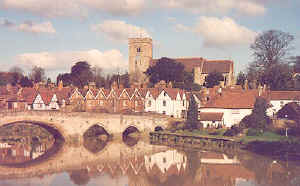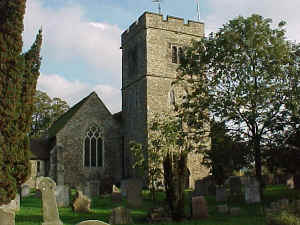The Culpeper Monument at the
Church of St. Peter & St. Paul
Aylesford, Kent, England
Aylesford
 Just north of Maidstone is the picturesque village of Aylesford.
Having traveled these many miles from Pegwell Bay, the Jutish
leaders Hengist and Horsa vanquished the ancient Britons at
Aylesford in a great battle in 455 AD. This was frankly
unsporting of them, having been invited into Britain by the
British ruler Vortigern to help him defend the country from his
enemies! Horsa died in battle, leaving Hengist and his son Aesc
to establish the kingdom of the Cantware, or "men of
Kent". For 300 years, the kingdom was ruled by the
descendants of Aesc - the dynasty of the Eskings.
Just north of Maidstone is the picturesque village of Aylesford.
Having traveled these many miles from Pegwell Bay, the Jutish
leaders Hengist and Horsa vanquished the ancient Britons at
Aylesford in a great battle in 455 AD. This was frankly
unsporting of them, having been invited into Britain by the
British ruler Vortigern to help him defend the country from his
enemies! Horsa died in battle, leaving Hengist and his son Aesc
to establish the kingdom of the Cantware, or "men of
Kent". For 300 years, the kingdom was ruled by the
descendants of Aesc - the dynasty of the Eskings.
In Aylesford's High Street is the splendid
medieval Friary built by the Carmelites around the middle of the
13th century. This was the first Carmelite order to be founded
in Europe. Following the Dissolution of the Monasteries by Henry
VIII in 1536, the Friary was rebuilt in 1675, but the main part
of the house was destroyed in the 1930's. The Carmelites took
over the house in 1949 and have successfully restored it to its
former glory.
Aylesford exudes history and charm as it sits
demurely on the banks of the Medway. As an important river
crossing, it has seen a great deal of activity throughout the
centuries. A beautiful five-arched medieval bridge spans the
river, and the surrounding jumble of timbered and gabled
dwellings ensures that many visitors stop to muse for a while.
It is not surprising that countless photographers and painters,
both professional and not so professional, have eagerly
attempted to capture the tranquil beauty of Aylesford over the
years.
Source:
Sean Connolly, Ed., The Hidden Places of Kent, Travel
publishing, Ltd., 1998.
Village of Aylesford Location:
14 miles N of
Goudhurst.
National Grid Coordinates: TQ 726 591
|
1831 Topographical Dictionary
AYLESFORD, a parish in the hundred of LARKFIELD, lathe of AYLESFORD, county of KENT, 3.5 miles
(N.N.W.)
from Maidstone, and 34 (S. E.) from London, containing 1136
inhabitants. This place, by the Britons, was called
Saissenaig-hobail, in commemoration of their having here
defeated the Saxons; and by the latter, after their settlement
in the country, Eaglesford, of which the present name is a
corruption: in the battle above mentioned, which took place in
455, Horsa, the brother of Hengist, was slain. In 893, Alfred
defeated the Danes at Fenham in this parish, and, in 1016,
Edmund Ironside, in a fierce encounter with those invaders,
pursued them to this place with great slaughter, and drove them
hence to Sheppey. In 1240, Ralph Frisburn, on his return from
the Holy Land, founded a Carmelite monastery under the patronage
of Richard, Lord Grey of Codnor, many parts of which are still
entire, though the greater part of the site is occupied by a
mansion, erected by Sir William Sedley, and now the residence of
the Earl of Aylesford. The town is pleasantly situated on the
north-east bank of the river Medway, over which is a neat modern
stone-bridge of six arches; it consists of one principal street,
on the east side of which the ground rises abruptly to an
elevation of one hundred feet. The church, dedicated to St. Peter, is situated on
rising ground to the east of the principal street. Military relics are frequently discovered here: at
Horsted,
there is a monument of upright stones, erected, as it is
supposed, to the memory of Horsa; and three miles distant is
another, called Kit's Cotty house, to the memory of Certigorn,
brother of Vortimer, who was slain with that prince in the
battle with Hengist and Horsa. Sir Charles Sedley, a celebrated
wit and poet in the reign of Charles II, was a native of this
parish. |
|
On a hill above the village of Aylesford stands the ancient
Church of St. Peter and St. Paul.
 In the 14th, 15th and 16th
centuries, the Preston Hall Culpepers, whose manor
was across the Medway from Aylesford, were connected with the
more distant parish churches of East Farleigh and West Peckham.
They do not appear in the records of the parish of St. Peter and
St. Paul until the late 16th century. Perhaps, until the Medway
bridge was built, the parish lines respected the natural
boundary of the Medway. In the 14th, 15th and 16th
centuries, the Preston Hall Culpepers, whose manor
was across the Medway from Aylesford, were connected with the
more distant parish churches of East Farleigh and West Peckham.
They do not appear in the records of the parish of St. Peter and
St. Paul until the late 16th century. Perhaps, until the Medway
bridge was built, the parish lines respected the natural
boundary of the Medway.
|
The Culpeper Monument
Against the east gable and under the central piers of the
chancel of the parish church at Aylesford is one of the finest
rectangular tomb chests in Kent. This well-preserved monument of
Elizabethan style supports the life-size recumbent effigies of a knight,
Sir Thomas Culpeper15p (died 1604) and his lady, Dame Marie. It
is in grey alabaster mottled with veins of iron oxide.
|

Monument from Sir Thomas' side |

Monument from Dame Marie's side
|
|
|
Surmounting is the effigy of a bearded bare-headed knight,
Sir Thomas, in black armour edged in gilt. His bare hands are clasped together in an
attitude of prayer. After the Dutch fashion introduced during
Elizabethan times, he lies on a rush mat with rolled up ends, on one of
which rests his sabot on heels. He wears rowel spurs. Contrary to
tradition, there is no canine effigy at his feet. Probably, this was
because he was a farmer, not a soldier.
In the central bay beneath him are carved effigies
of three kneeling sons, viz. William, Richard and Thomas.
On his left is his lady, Dame Marie. Her hands
are similarly clasped
together. Both effigies are orientated with the feet pointing eastwards.
Under each head is carved a cushion with piped edges, gilt brocade on the
upper surface, and heavy tassels at each corner.
The lady wears a plain white dress draped from the neck and
tucked in concealing her feet. A plain white shawl is pleated over the
head and cascades below the knee. The absence of jewelry is particularly
remarkable. The rather somber nature of the lady's apparel is in contrast
to the ostentation of her husband.
Similar to the sons found below her
husband, in the central bay beneath Dame Marie are carved effigies of
three kneeling daughters, viz. Francisca, Maria and Ann.
An inscription on the west end of the monument
records:
Here liethe intombed Sir Thomas Colepeper, Knighte,
by bloode & descente descended of many worthye ancestors: in his
life time for his worth and desarte beloved of all men: and in his death
as much lamented and bemoned: he had by Dame Marie, his only wife at the
time of his decease, three sonnes and two daughters: which Dame Marie to
performe her last duty in remembrance of her faithfull love to her
deceased husband at her owne cost erected this gratefull monumente:
under which he resteth and by his lively faithe hopeth a joyfull
resurrection. He died 12 Oct 1604.
This monument is embellished with armorial bearings in
colour of six coats quarterly:
-
Argent, a bend engrailed gules (Arms of
Culpeper).
-
Argent, a chevron sable between nine martlets gules (Arms
of Hardreshall).
-
Gules, on a cross argent five escallops of the first.
-
Barry of four, vert and gules, three bezants, two and
one in chief a cross formee or.
-
Gules, seven mascles, three, three and one, or.
-
Sable, a fesse chequy argent and sable between three
owls proper, impaling azure a chevron argent between three lions'
heads erased, ermine crowned or.
The Culpeper crest is a falcon volant argent,
belled or.
A large undecorated floriated armorial device on the east
end is obscured by the close proximity of the column of the east wall of
the chancel.
There is an anomaly concerning the effigies carved on the
sides of the monument, and the text of the inscribed tablet on the west
end. This is probably the original stone commemorating Sir Thomas's
interment in 1604. Dame Marie was probably pregnant when her husband died,
such that the birth of the third daughter, Ann, was posthumous.
Their eldest son, Sir William, commissioned the imposing
monument after 1604 to commemorate not only his father but also his
mother. The original simple tablet pertinent to his father, of dissimilar
stone, was incorporated into this later design.
There is no evidence on the monument to identify the
sculptor. However, the style in Dame Marie's
effigy resembled that of Lady Elizabeth's black and white marble tomb
chest in All Saints Church, Hollingbourne. Lady Elizabeth's monument was the work of the
sculptor Edward Marshall (1578-1675). His signature was incised on the top
molding of the west side of the plinth. E. Marshall was also employed by the Culpeper family to create
two delightful memorial brasses at Ardingly, Sussex.
Source:
James H. Sephton, Preston Hall, Aylesford,
1997. 
Also see Preston Hall,
in Aylesford
|
Last Revised:
02 Jan 2015
|
|